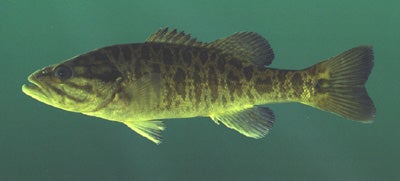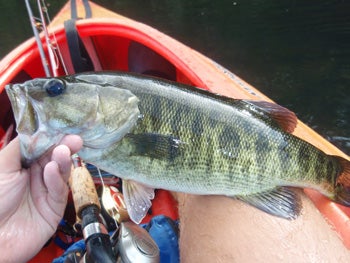SCIENTIFIC NAME:
Micropterus cataractae
CHARACTERISTICS:
The shoal bass and the redeye bass are easily confused, even though the two have nonoverlapping ranges. Redeye bass have white margins on the upper and lower edges of the caudal fin; white fin margins are absent on shoal bass. Whereas redeye bass have teeth on the tongue, shoal bass do not. Additionally, Page and Burr (1991) report that redeye bass have slightly larger scales, resulting in lower lateral line counts (64 to 73, compared to 70 to 79 in shoal bass) and a lower number of scale rows around the caudal peduncle (26 to 30, compared to 29 to 34). Adult shoal bass are olive green on the back and white on the venter. Several rows of darkened scales form distinct parallel lines along the lower sides of the body. Small individuals have along their sides several vertical, dark blotches that fade somewhat with age.
ADULT SIZE:
12 to 18 in (305 to 460 mm).
STATE RECORD:
a list of the State Record Freshwater Fish.
DISTRIBUTION:
Shoal bass are endemic to the Apalachicola River drainage in Alabama, Florida, and Georgia.
HABITAT AND BIOLOGY:
Shoal bass inhabit shoals and riffles of small to moderate fast-flowing streams and apparently avoid reservoirs. Carlander (1977) reports a diet of aquatic insect larvae, crayfish, and small fishes. Spawning occurs from later April into May.
ORIGINAL DESCRIPTION:
Williams and Burgess described the shoal bass in 1999.
ETYMOLOGY:
Micropterus means small fin.
Cataractae means waterfalls, referring to the shoal habitat.
The copyrighted information above is from Fishes of Alabama and the Mobile Basin.








